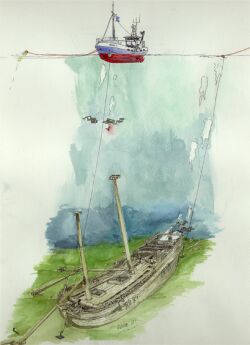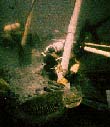InvestigationThe standard procedures of examination, measuring and excavation are usually followed under water, often helped by an airlift or a water dredge. A large grid is often placed over a site to facilitate measuring and photo, perhaps creating a photo mosaic. Objects can also be positioned by triangulation to fixed base points. Sometimes wrecks are excavated on land. Examples are: (1) Wrecks are found on land, e.g. in bogs, drained harbour areas or in grave mounds. (2) In shallow water, the wreck site can be drained, like at Skuldelev. (3) The wreck is lifted, like the Vasa ship. The actual excavation sometimes uses stratigraphy just like land archaeology, going down in time layer by layer. But the silting and build-up of sediment around a shipwreck is different from land. In salt seas most of the wood is destroyed by the “shipworm” teredo navalis. After some time the remaining lower parts are covered and protected by sediment or sand (in seas with sand bottom), thus buried under a shallow mound.
|
Vrouw Maria fieldwork airlift measuring |



 Back to Nordic Underwater Archaeology
Back to Nordic Underwater Archaeology